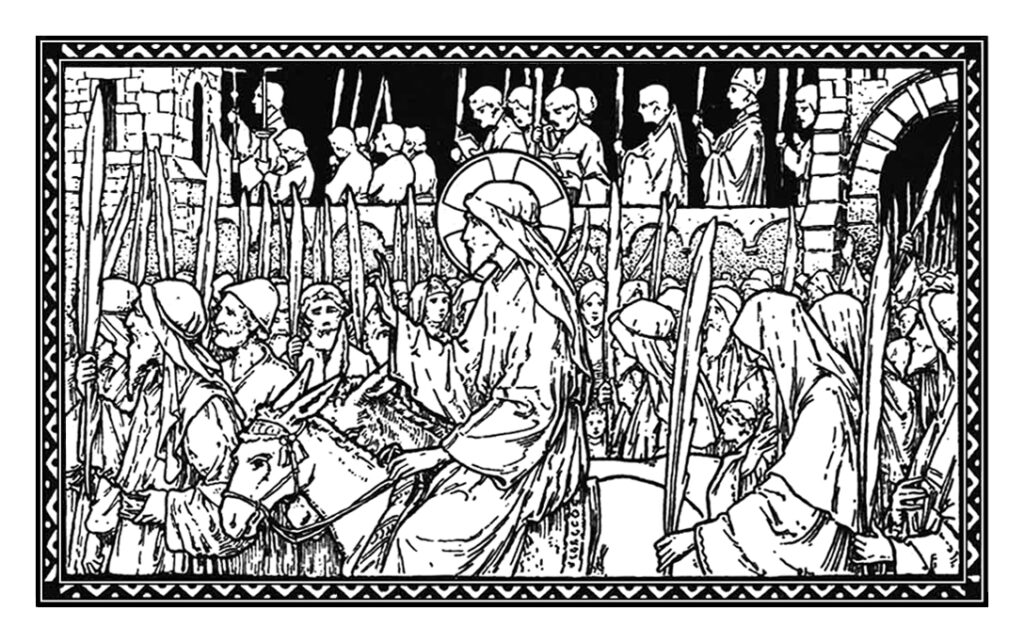Home l Liturgy & Sacraments l Liturgical Calendar
Palm Sunday

In today’s liturgy the twofold point of view from which the Church regards the Cross is expressed in two ceremonies, one marked by joy and the other by sadness, First comes the Blessing and Procession of Palms in which everything overflows with a holy joy which enables us after twenty centuries to revive the spirit of the magnificent scene of our Lord’s triumphal entry into Jerusalem. Then follows the Mass whose chants lessons relate exclusively to the sorrowful memory of our Redeemer’s Passion.
It is very important to recognize that our Lord preparing to come into Jerusalem, riding in on a donkey and the Passion (a foreshadowing of what is coming at the end of the week) go together. Christ rides triumphant into Jerusalem, though He has not yet conquered death. He comes now not so much to manifest His glory and power, as conquerors do, but rather to show us His humility by which He conquers.
The Blessing and Procession of Palms
At Jerusalem, in the fourth century, on the very spot where the event took place, was read the Gospel narrative in which we see Christ, hailed as King of Israel and taking possession of His capital, Jerusalem, which is really no more than the type of Jerusalem above. After this a bishop, mounted on an ass, rode up to the church of the Resurrection on the summit of the mount of Olives, surrounded by a multitude carrying palms and singing anthems and hymns. This ceremony was preceded by the reading of the passage from Exodus in which are mentioned the palm-trees, near the twelve foundations where Moses promised the manna: these were types of the coming Redemption, and of the sacraments of Baptism and Eucharist, by which the fruits of Redemption were to be applies to souls about Easter.
The Church of Rome, it would seem, adopted this practice about the ninth century and added to it the rite for the Blessing of the Palms. This blessing took place at St. Mary Major, from where the procession went to the stational church of St. John Lateran. In this benediction, the Church prays for health of mind and body for those who dwell in houses where the palms are preserved. The Church adds that the branches of palms signify Jesus’ triumphs over the prince of death and the branches of olives proclaim, in a manner, the coming of spiritual unction.
This procession of Christians, who with palm in hand and songs of Hosanna on their lips, proclaim Christ’s Kingship every year, throughout the whole world and in all generations, is composed of all catechumens, of public penitents, and of the faithful, who at the Easter Feast will go forth to meet our glorious Victor through the sacraments of Baptism, Eucharist, and Penance.
At the door of the Church, some members of the choir have already gone in, and they chant alternately with the clergy the “Gloria laus”: on the one side “the angelic choir”, and on the other Christ’s soldiers, still plunged in the strife of battle. The door opens after the subdeacon has knocked on it three times with the foot of the cross; so does the cross of Christ open heaven to us.
We should keep a blessed palm carefully in our home. It is a sacramental which will obtain for us graces in virtues of the Church’s prayer. Fixed to a Crucifix, it reminds us of Christ’s victory on the Cross.
Copyright © 2015-2024 Saint Joseph Catholic Church, Latin Mass Parish, 602 S 34th St., Tacoma, WA 98418. All Rights Reserved.
Website comments or questions: info@saintjosephtacoma.org


